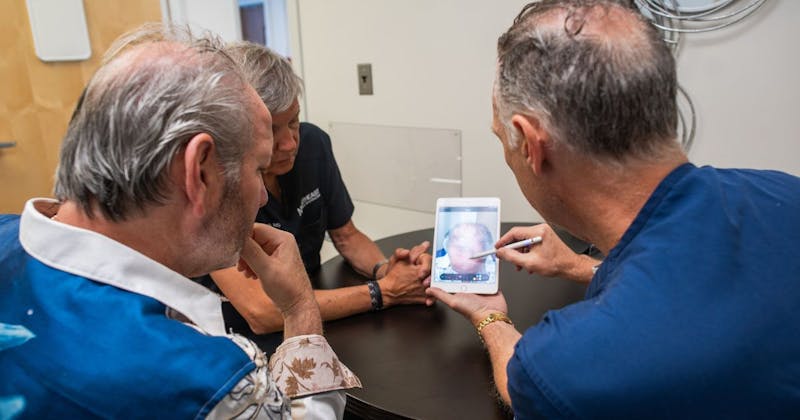Rooted in Results Let’s Get Growing
Hair loss is a symptom. We begin every journey by finding the cause, so your treatment plan isn’t just hopeful—it’s strategic, personalized, and proven to work.
Contact Our Team
Watching your hairline recede over the years can feel like you’re losing a part of your identity, chipping away at your confidence more and more each day. Thankfully, there are options available to you to address these concerns and reclaim your self-esteem. If you’re thinking about a hair transplant but not sure which way to go, knowing the difference between No Shave FUE hair transplant and Traditional FUE hair transplant will be priority #1. Today we’ll explore each method (No Shave FUE vs. traditional FUE) to help you make the most informed decision possible.
Unlike the “plugs” of the 80s, new techniques have emerged in recent years that are gaining in popularity. One such technique is FUE, or Follicular Unit Extraction, which involves moving individual follicles from the donor area to restore hair loss.
Under the FUE umbrella are two main procedures to choose from: No Shave FUE vs the Traditional FUE. Our Boston hair loss specialists use the latest technologies and advanced techniques to restore your hair – and your confidence – as discreetly as possible.
First off, let’s go into more depth on FUE overall and its role in modern hair transplants. As one of the most popular treatments for hair transplantation, FUE offers several benefits over older methods such as FUT, including:
With a FUE hair transplant, your surgeon will use a small circular punch to carefully extract follicles before all grafts are harvested. They will then implant those follicles at the recipient site. Because the tool used is only about the diameter of a pencil point, the scarring risk is minimal. In fact, in most cases, there is no visible scarring at all.
Before FUE was an option, the go-to method was Follicular Unit Transplantation (FUT). This procedure involves moving a strip of hair-bearing scalp from the back of the donor area. The most significant drawback of this method is the linear scar that remains afterwards. Other drawbacks include a longer recovery time due to the use of sutures or staples.
On top of that, there is more post-op discomfort and higher risk of infection. In addition, patients are advised to avoid strenuous activity for a few weeks after the procedure.
With FUE, because follicles can be removed one at a time and from areas other than the scalp, the risk for scarring is very low. In addition, the recovery time is much faster and post-op comfort is higher.
Traditional Follicular Unit Extraction (FUE) moves individual follicles from a donor area to another location using a small punch. This is unlike the FUT, or strip method, where a strip of scalp is removed and the follicles are split up after that. This often brings more discomfort and higher chance for scarring.
With a traditional FUE hair transplant, follicles are removed one at a time. This leaves no linear scar at the donor site so that the transplant is less noticeable. This brings less discomfort to the patient and recovery is quicker. However, the one downside to traditional FUE is that partial or full shaving of the donor area is required to perform the extraction. This can lead to an awkward haircut until the hair grows back.
With this method, maintaining discretion is impossible or difficult, as the visible signs make it clear to others that a hair transplant has been performed.
This brings us to the No Shave FUE hair transplant and why it’s an even better alternative when discretion is valued.
The No Shave FUE is similar to traditional FUE in that individual follicles are taken from the donor site one at a time and implanted at the area of concern. However, the main difference here is that no shaving is involved.
This breakthrough advancement in hair restoration utilizes specialized technology whereby surgeons can extract individual grafts without shaving the surrounding hairs. This results in a discreet hair transplant that looks natural and isn’t immediately obvious to others.
Because the No Shave FUE conceals evidence of the procedure, this is particularly beneficial for public-facing professionals or anyone else who wants to maintain privacy.
From shaving requirements to downtime, here are some key differences between the No Shave FUE hair transplant and the traditional FUE hair transplant.
In the end, the decision to go with a traditional FUE hair transplant or a No Shave FUE hair transplant is a highly personal one. Some factors to keep in mind before deciding include:
It’s also important to consult a qualified hair loss specialist in Worcester. After a full consultation and exam, your surgeon will be able to recommend the best approach for you. Not everyone is a good candidate for either procedure. The only way to know for sure is to book a free in-person consultation with Northeast Hair Restoration.
Here at Northeast Hair Restoration, we have more than 35 years of experience and more than 8,000 hair restoration procedures in Boston and Worcester under our belts. Backed by personalized consultations and natural-looking results, you can trust our hair loss specialists to handle your hair transplant, no matter which method you go with.
Ready to take the next step in hair restoration and reclaim your confidence? Book your private consultation with our experts today to discuss your options.